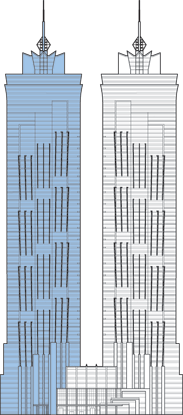Filter by
You must be a CTBUH Member to view this resource.

JW Marriott Marquis Hotel Dubai Tower 1
Emirates Park Towers Hotel & Spa 1, Emirates Park Tower 1
Building
Completed
2012
Hotel
All-Concrete
355.4 m / 1,166 ft
82
2
804
1045
14
6 m/s
97,944 m² / 1,054,260 ft²
You must be a CTBUH Member to view this resource.
You must be a CTBUH Member to view this resource.
Proposed
Construction Start
Completed
The Design Engineer is usually involved in the front end design, typically taking the leadership role in the Schematic Design and Design Development, and then a monitoring role through the CD and CA phases.
The main contractor is the supervisory contractor of all construction work on a project, management of sub-contractors and vendors, etc. May be referred to as "Construction Manager," however, for consistency CTBUH uses the term "Main Contractor" exclusively.
Other Consultant refers to other organizations which provided significant consultation services for a building project (e.g. wind consultants, environmental consultants, fire and life safety consultants, etc).
Material Supplier refers to organizations which supplied significant systems/materials for a building project (e.g. elevator suppliers, facade suppliers, etc).
You must be a CTBUH Member to view this resource.
Usually involved in the front end design, with a "typical" condition being that of a leadership role through either Schematic Design or Design Development, and then a monitoring role through the CD and CA phases.
The Design Engineer is usually involved in the front end design, typically taking the leadership role in the Schematic Design and Design Development, and then a monitoring role through the CD and CA phases.
The Design Engineer is usually involved in the front end design, typically taking the leadership role in the Schematic Design and Design Development, and then a monitoring role through the CD and CA phases.
The main contractor is the supervisory contractor of all construction work on a project, management of sub-contractors and vendors, etc. May be referred to as "Construction Manager," however, for consistency CTBUH uses the term "Main Contractor" exclusively.
Other Consultant refers to other organizations which provided significant consultation services for a building project (e.g. wind consultants, environmental consultants, fire and life safety consultants, etc).
Material Supplier refers to organizations which supplied significant systems/materials for a building project (e.g. elevator suppliers, facade suppliers, etc).
31 January 2018 - Event
13 October 2016 - CTBUH Research

31 December 2012
Kevin Brass, Antony Wood & Marty Carver, CTBUH
For the first time in six years the number of tall buildings completed annually around the world declined as the effects of the global financial...
The Emirates Park Towers represent a twin-tower hotel complex sitting on an “L”-shaped plot in Dubai between the Sheikh Zayed Road to the west and Business Bay to the east. This plot will adjoin a future extension of the Dubai Creek, with a waterside promenade on the south side.
The design of Emirates Park Towers is inspired by the date tree, a recognized symbol of Arab culture. The faceted appearance of the tree’s trunk is reflected in the plan of the guest floors. The balconies are extruded out to suggest a layered bark pattern. The building is an example of Expressionist architecture, in which the structure itself resembles a distorted shape.
The main structural core is placed in the middle of the plan. The central core and external shear walls are connected by outriggers to form the lateral load resisting systems. The shear walls are supported on transfer girders, which are then supported by core walls and peripheral columns. The towers are oriented intentionally for minimal peak thermal load and wind pressure, and feature vertical fins that act as shading devices.
The towers comprise 66 guest floors, eight service levels, and six intermediate levels. The off-axis orientation of the towers and the peripherally located hotel rooms maximize guests’ access to views of the nearby scenery, including the Arabian Gulf, Safa Park, and the Burj Kalifa. The podium provides a central nest of activity for the towers: with 18 restaurants and bars, an extensive business center with conference halls and meeting rooms, a banquet hall, spa and health club, as well as retail outlets, a swimming pool, and a gymnasium.
31 January 2018
CTBUH Executive Director Antony Wood and Events Manager Jessica Rinkel-Miller traveled to Dubai in preparation for the 2018 Middle East Conference.
13 October 2016
The Council is pleased to announce the Top Company Rankings for numerous disciplines as derived from the list of projects appearing in 100 of the World’s Tallest Buildings.
Subscribe below to receive periodic updates from CTBUH on the latest Tall Building and Urban news and CTBUH initiatives, including our monthly newsletter. Fields with a red asterisk (*) next to them are required.
View our privacy policy